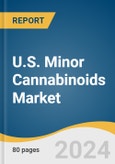Minor cannabinoids have potential therapeutic benefits, including anti-inflammatory, analgesic, and neuroprotective effects. There is a growing interest in developing pharmaceuticals and nutraceuticals containing minor cannabinoids for the treatment of various medical conditions, such as chronic pain, anxiety, and sleep disorders. For instance, in January 2021, Lygos, Inc. announced the commercial availability of cannabichromene (CBC) that has a wide range of anti-inflammatory, antioxidant, and pain management properties.
Wellness products such as supplements, tinctures, and topicals incorporate minor cannabinoids. These products are marketed as natural remedies for various health issues, and are becoming popular among consumers who are looking for alternatives to traditional medications. For instance, Nextraction, a supplier of personal care and health & wellness products, launched Kriva - a range of Cannabinol (CBN), cannabidiol acid (CBDA), and Cannabigerolic acid (CBGA) - in topical and ingestible formulas.
Various organic and inorganic developments done by key players to strengthen their business avenues and footprints in the U.S. minor cannabinoids industry are anticipated to facilitate market expansion over the forecast period. In October 2022, Purissima, Inc., a biotechnology company in partnership with Open Book Extracts (OBX), launched its first fermentation-derived natural CBC products such as gummies, topical serums, tinctures, and capsules.
U.S. Minor Cannabinoids Market Report Highlights
- Based on product type, the tetrahydrocannabivarin (THCV) segment dominated the market with a revenue share of 25.9% in 2023, owing to increasing application of THCV in the management of conditions such as arthritis, metabolic disorders, and epilepsy
- Based on application, the neurological disorders segment accounted for a significant revenue share in 2023, due to the rising prevalence of neurological disorders and applications of cannabinoids in their management
- Some of the major market players include GCM Holdings (Global Cannabinoids), LLC, GenCanna, Mile High Labs, ZERO POINT EXTRACTION, LLC, BulKanna, and CBD. INC.
Table of Contents
Companies Mentioned
- Mile High Labs
- GCM Holdings, LLC
- GenCanna.
- CBD. INC.
- Rhizo Sciences
- Laurelcrest
- Fresh Bros Hemp Company
- BulKanna
- High Purity Natural Products
- ZERO POINT EXTRACTION, LLC
Methodology

LOADING...
Table Information
| Report Attribute | Details |
|---|---|
| No. of Pages | 80 |
| Published | January 2024 |
| Forecast Period | 2023 - 2030 |
| Estimated Market Value ( USD | $ 11.5 Billion |
| Forecasted Market Value ( USD | $ 33.3 Billion |
| Compound Annual Growth Rate | 15.0% |
| Regions Covered | United States |
| No. of Companies Mentioned | 10 |









